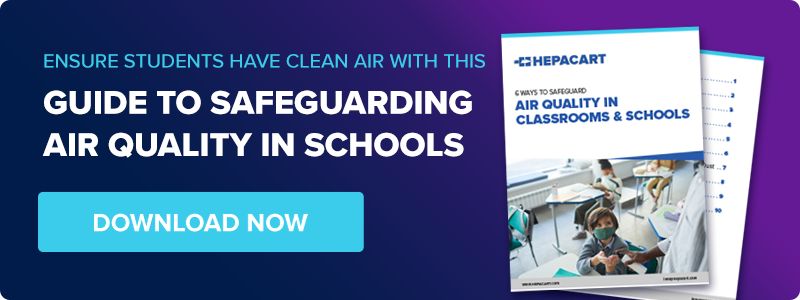 Are you looking to provide a safe and comfortable environment for staff and students? Keeping classrooms protected from indoor air quality (IAQ) issues is important for protecting against COVID-19, but also for many other reasons as well. But what should you look for when trying to improve IAQ? In this blog we will explore why schools need to prioritize IAQ, the potential negative consequences of poor IAQ, and how you can improve IAQ in your school today.
Are you looking to provide a safe and comfortable environment for staff and students? Keeping classrooms protected from indoor air quality (IAQ) issues is important for protecting against COVID-19, but also for many other reasons as well. But what should you look for when trying to improve IAQ? In this blog we will explore why schools need to prioritize IAQ, the potential negative consequences of poor IAQ, and how you can improve IAQ in your school today.
Why Should I Make My Classroom IAQ a Priority?
Did you know that according to the EPA, the average age of main school buildings in the United States is 55 years old? In addition to that, almost one-fourth of schools have one or more buildings that should be repaired or replaced, and nearly half of those have poor IAQ. The biggest reason that you should make good IAQ a priority in your classrooms is because students and staff are dependent on good IAQ to help them learn and be productive. By providing a healthy and comfortable environment for students and staff, you are investing in them for the long term.

There are five key IAQ issues that many schools face:
- Infiltration of Ambient Air Pollution: IAQ is influenced by the air outside, because the air outside is always infiltrating the building. Pollutants tend to accumulate once they are inside, leading to the concentration of pollutants inside being up to five times higher than outside.
- Allergens & Asthma Triggers: Pollen, dust mites, and pests can all cause allergic reactions in many people, which mimic the symptoms of a cold. These allergens also cause asthma symptoms in those who have the disease.
- Dampness & Mold: Building dampness and mold can cause the same symptoms that an individual might experience during an allergic reaction. They can also aggravate asthma.
- Levels of Carbon Dioxide: An elevated level of carbon dioxide (CO2) in a school can lead to poor concentration and cognitive performance as well as physical symptoms like wheezing.
- Radon: This colorless and odorless gas can leak into buildings through cracks in the floor. It is the byproduct of radioactive elements breaking down in rocks and soil, and is the number one cause of lung cancer among non-smokers.
What are the Negative Consequences of Poor IAQ in Classrooms?
There are four main negative consequences of poor IAQ in classrooms. These are an increase in short and long term health problems for your students and staff, the potential for costly repairs, the potential for liability problems, and a greater risk that some or all of the school will need to close and temporarily relocate its staff and students. Additionally, it is now thought by some that the mental health of developing minds may be affected by prolonged exposure to poor IAQ.
Some of the known short term health problems that can be caused by poor IAQ include eye, nose, and throat irritation, as well as headaches. Long term health conditions may include diabetes, cardiovascular disease, and respiratory issues. While anyone can be adversely affected by poor IAQ, it is known that children are the most vulnerable to poor IAQ because their bodies are still growing and changing.
How Can I Improve the IAQ in my Classrooms?
Now that you know about the risks of poor IAQ in your classrooms, it is only natural that you want to know how to improve it. Let’s take a look at four ways you can improve the air quality in your classrooms:
- Ventilation: The ventilation system in your school can play a critical role in diluting the pollutants that are concentrated inside the classrooms. A good ventilation system brings fresh air in from the outdoors, and is a good way to meaningfully improve the academic performance of children without spending a lot of money or energy. As long as the outdoor air quality is good, opening windows and disabling demand controlled ventilation (DCV) are both helpful options.
- Purification: Air purifiers are another easy way to reduce the concentration of pollutants in the classroom. Portable air purifiers can be used in a variety of places, and not only do some of them capture and deactivate bacteria and viruses, they can trap particulate matter.
- Indoor Air Quality Monitoring: Indoor air quality monitors can help you identify what exact IAQ remediation steps you need to take. Most of these monitors can track air pollutants like TVOCs or PM10, as well as other air quality factors like CO2 and humidity. You can find many easy to use indoor air quality monitors available online.
- Outdoor Air Quality Monitoring: Since we know outdoor air pollutants can get inside quite easily, it is important to know what is in the air outside your classroom. Resources such as AirNow or Breezometer can supply real time air quality information. If you know the air quality outside is poor, it is time to keep the windows closed.
